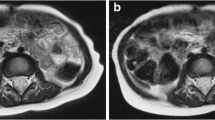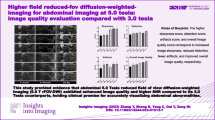Abstract
Objective
To compare image quality of turbo spin-echo (TSE) with BLADE [which is also named periodically rotated overlapping parallel lines with enhanced reconstruction (PROPELLER)] on magnetic resonance imaging (MRI) for upper abdomen.
Materials and methods
This study involved the retrospective evaluation of 103 patients (63 males, 40 females; age range 19–76 years; median age 53.8 years) who underwent 3.0 T MRI with both conventional TSE T2-weighted imaging (T2WI) and BLADE TSE T2WI. Two radiologists assessed respiratory motion, gastrointestinal peristalsis, and vascular pulsation artifacts, as well as the sharpness of the liver and pancreas edges. Scores for all magnetic resonance (MR) images were recorded. Wilcoxon’s rank test was used to compare hierarchical data. Cohen’s kappa coefficient was adopted to analyze interobserver consistency.
Results
Compared to TSE T2WI, BLADE TSE T2WI reduced all of the examined motion artifacts and increased the sharpness of the liver and pancreas edges (all P < 0.05). Medium to good interobserver consistency was obtained for evaluating these indicators. The scanning time of BLADE TSE T2WI was 4–16 s shorter than that of conventional TSE T2WI.
Conclusion
Compared to TSE sequence, the BLADE technique can reduce the respiratory motion, gastrointestinal peristalsis, and vascular pulsation artifacts, while decreasing the scanning time and improving the anatomic detail and image quality.



Similar content being viewed by others
References
Rofsky NM. Abdominal MRI: update. Top Magn Reson Imaging. 2014;23(2):71.
Bayramoglu S, Kilickesmez O, Cimilli T, Kayhan A, Yirik G, Islim F, et al. T2-weighted MRI of the upper abdomen: comparison of four fat-suppressed T2-weighted sequences including PROPELLER (BLADE) technique. Acad Radiol. 2010;17(3):368–74.
Chang KJ, Kamel IR, Macura KJ, Bluemke DA. 3.0-T MR imaging of the abdomen: comparison with 1.5 T. Radiographics. 2008;28(7):1983–98.
Mirowitz SA. Diagnostic pitfalls and artifacts in abdominal MR imaging: a review. Radiology. 1998;208(3):577–89.
Pipe JG. Motion correction with PROPELLER MRI: application to head motion and free-breathing cardiac imaging. Magn Reson Med. 1999;42(5):963–9.
Huang TY, Tseng YS, Tang YW, Lin YR. Optimization of PROPELLER reconstruction for free-breathing T1-weighted cardiac imaging. Med Phys. 2012;39(8):4896–902.
Hirokawa Y, Isoda H, Maetani YS, Arizono S, Shimada K, Togashi K. MRI artifact reduction and quality improvement in the upper abdomen with PROPELLER and prospective acquisition correction (PACE) technique. AJR Am J Roentgenol. 2008;191(4):1154–8.
Junping W, Tongguo S, Yunting Z, Chunshui Y, Renju B. Discrimination of axillary metastatic from nonmetastatic lymph nodes with PROPELLER diffusion-weighted MR imaging in a metastatic breast cancer model and its correlation with cellularity. J Magn Reson Imaging. 2012;36(3):624–31.
Tan H, Hoge WS, Hamilton CA, Gunther M, Kraft RA. 3D GRASE PROPELLER: improved image acquisition technique for arterial spin labeling perfusion imaging. Magn Reson Med. 2011;66(1):168–73.
Holmes JH, Beatty PJ, Rowley HA, Li Z, Gaddipati A, Zhao X, et al. Improved motion correction capabilities for fast spin echo T1 FLAIR propeller using non-cartesian external calibration data driven parallel imaging. Magn Reson Med. 2012;68(6):1856–65.
Darge K, Anupindi SA, Jaramillo D. MR imaging of the abdomen and pelvis in infants, children, and adolescents. Radiology. 2011;261(1):12–29.
Aksoy M, Skare S, Holdsworth S, Bammer R. Effects of motion and b-matrix correction for high resolution DTI with short-axis PROPELLER-EPI. NMR Biomed. 2010;23(7):794–802.
Lane BF, Vandermeer FQ, Oz RC, Irwin EW, McMillan AB, Wong-You-Cheong JJ. Comparison of sagittal T2-weighted BLADE and fast spin-echo MRI of the female pelvis for motion artifact and lesion detection. AJR Am J Roentgenol. 2011;197(2):W307–13.
Froehlich JM, Metens T, Chilla B, Hauser N, Klarhoefer M, Kubik-Huch RA. Should less motion sensitive T2-weighted BLADE TSE replace cartesian TSE for female pelvic MRI? Insights Imaging. 2012;3(6):611–8.
Fujimoto K, Koyama T, Tamai K, Morisawa N, Okada T, Togashi K. BLADE acquisition method improves T2-weighted MR images of the female pelvis compared with a standard fast spin-echo sequence. Eur J Radiol. 2011;80(3):796–801.
Dietrich TJ, Ulbrich EJ, Zanetti M, Fucentese SF, Pfirrmann CW. PROPELLER technique to improve image quality of MRI of the shoulder. AJR Am J Roentgenol. 2011;197(6):W1093–100.
Jin N, Guo Y, Zhang Z, Zhang L, Lu G, Larson AC. GESFIDE-PROPELLER approach for simultaneous R2 and R2* measurements in the abdomen. Magn Reson Imaging. 2013;31(10):1760–5.
Yamaguchi M, Mitsuda M, Ezawa K, Nakagami R, Furuta T, Sekine N, et al. Artifact-reduced simultaneous MRI of multiple rats with liver cancer using PROPELLER. J Magn Reson Imaging. 2013;38(1):225–30.
Mateos-Fernandez M, Mas-Estelles F, de Paula-Vernetta C, Guzman-Calvete A, Villanueva-Marti R, Morera-Perez C. The role of diffusion-weighted magnetic resonance imaging in cholesteatoma diagnosis and follow-up. Study with the diffusion PROPELLER technique. Acta Otorrinolaringol Esp. 2012;63(6):436–42.
Henrik HJ, Kramer H, et al. Renal T2-weighted turbo-spin-echo imaging with BLADE at 3.0 Tesla: initial experience. JMRI. 2008;27(1):148–53.
Lavdas E, Topalzikis T, Mavroidis P, Kyriakis I, Roka V, Kostopoulos S, et al. Comparison of PD BLADE with fat saturation (FS), PD FS and T2 3D DESS with water excitation (WE) in detecting articular knee cartilage defects. Magn Reson Imaging. 2013;31(8):1255–62.
Author information
Authors and Affiliations
Corresponding author
Ethics declarations
Conflict of interest
We declare that we have no conflicts of interest.
About this article
Cite this article
Zhang, L., Tian, C., Wang, P. et al. Comparative study of image quality between axial T2-weighted BLADE and turbo spin-echo MRI of the upper abdomen on 3.0 T. Jpn J Radiol 33, 585–590 (2015). https://doi.org/10.1007/s11604-015-0463-9
Received:
Accepted:
Published:
Issue Date:
DOI: https://doi.org/10.1007/s11604-015-0463-9




